Conventional solid fuel boilers have one drawback. They require increased attention. It is necessary to put fuel in time, clean it, etc. Solid fuel boilers can overcome these inconveniences. long burning designed for a long cycle of work. What provides this convenience?
Installation of uninterrupted supply of bulk fuel
The principle is very simple. A bunker is connected to the boiler, into which, as a rule, wood pallets are loaded. Screw feed sends them to the furnace, where they burn. The convenience lies in the fact that, thanks to the impressive capacity of the bunker and automatic fuel supply, you can forget about the boiler for a while and calmly go about your business.
The Czech company Viadrus produces a range of solid fuel boilers equipped with bunkers.
Ekoret. It can work on wood pellets, brown and hard coal. Power, depending on the configuration, is achieved from 4.5 to 25 kW. The combustion chamber is made of steel, protected by ceramic plates. Cast iron heat exchanger. Fuel supply, pump and fan operation are controlled by automation connected to a temperature sensor. In case of overheating, protection is provided by a safety thermostat.
Hercules ECO. Solid fuel boilers long burning of this model range have a capacity of 7 to 42 kW. They work on wood pellets. A distinctive feature is automatic ignition, the ability to work with solar systems, equithermal regulation of boiler and heating water. Exhaust gases contain minimal amount emitted harmful substances, due to which this series received the Ecological economical product mark. Fuel is transported through a flexible hose thanks to a screw feed. The boilers are equipped with a safety thermostat.
These long-burning solid fuel boilers can be equipped with bunkers of various sizes, which can be connected to the unit both on the left and on the right.
Pyrolysis boilers
Solid fuel boiler Buderus Logano S121-2 German production. Made of steel, depending on the configuration, it can provide power from 18 to 38 kW. It can perform both a solo part and perform in a duet with a gas or liquid fuel boiler. Perfectly copes with work in gravitational and pumping system.
Convenient control panel, which has, among other things, automatic control of the fan control, depending on the temperature of the gases at the outlet.
A handy thing is the fan switch, which reacts to the opening of the door. Forced smoke gadfly prevents him from getting into the room when loading fuel. The fireclay brick protects the ash chamber from burning out. You can use logs up to 58 cm long. The fire chamber is easily cleared of products of burning.
solid fuel boiler Viadrus HEFAISTOS P1-5. Power is achieved up to 25 - 50 kW. It works on wood, which is burned at a rate of 7 to 14 kg / h. The device withstands water pressure up to 4 bar. The average water temperature is recommended within 60 - 90C.
The fan requires a reliable source of electricity to operate. If there are power outages, then you should purchase an uninterruptible power supply system. The boiler operates at 230 and 50 Hz.
The temperature is controlled by fans and pumps. Automation is connected to a thermometer. It is possible to connect a programmer and a room thermostat. Combustion occurs with minimal residue. The boiler is cleaned 1-2 times (depending on the intensity of work) per week.
For an autonomous heating system in areas with insufficient power supply, long-burning solid fuel boilers equipped with bunkers for bulk fuel are quite suitable. In the same place, where there are no problems with the supply of electricity, a solid fuel heating boiler on the pyrolysis principle is more profitable.
It is extremely difficult to imagine a comfortable house without a heating system, because the presence of heat in the room depends on its availability and functionality. The composition of such a system necessarily includes a heating boiler, the main task of which is to heat the coolant to a predetermined temperature. There are many types of equipment, the main difference of which is the type of fuel used, which determines the principle of operation of the device. According to statistics, solid fuel heating boilers, which are considered one of the first heating devices, are the most common.
How does such a unit work?
Solid propellant devices for their work use various types solid fuel. These are firewood, coal, oil shale, peat, etc. The cycle of operation of the boiler can be divided into three phases. Let's consider each of them in more detail.
Stage # 1 - ignition of the boiler
The cycle begins with ignition, which is characterized by a sharp increase in temperature from an average of 40°C to 600°C in 5-10 minutes. The temperature values of the combustion heat exchanger begin to grow, which depend on the parameters of the system and can range from 40°C to 70°C. At a minimum, thermal shock to the heating system as a whole and to the heat exchanger itself is possible. The latter, especially made of cast iron, cannot withstand such conditions for a long time and bursts. If the circulation rate of the coolant is low, and the heating is fast, the liquid may boil, which will lead to thermal and hydraulic shock to the heating system. The most vulnerable to it are plastic pipes. At this stage, the pipes begin to warm up, but the air in the room is still cold.
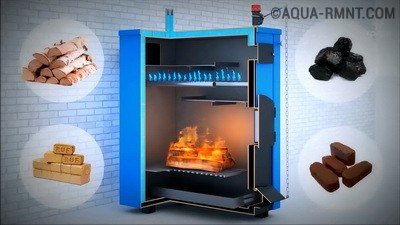
Coal, firewood, pellets, peat, etc. can be used as fuel for solid fuel type boilers.
Stage # 2 - warming up the coolant
The temperature in the furnace continues to rise and reaches values of 1300°C for coal-fired boilers and about 1000C for wood-burning ones. The coolant continues to warm up. At this stage, control is important, otherwise it can warm up to the maximum temperature of the boiler, which leaves 95 ° C, and this is already dangerous.
Regulation is carried out using a valve that controls the air supply. The optimum temperature must be maintained until complete combustion of the fuel. At this phase, the pipes in the room become hot, the air warms up.
Stage # 3 - fuel burnout
At the end of the boiler cycle, the fuel burns out completely, and embers are formed. The temperature drops to 600°C-400°C, which are considered the most comfortable for the system. The coolant slowly cools down, the air in the room also begins to gradually cool down. After glowing coals have formed, the process of cooling the air and coolant immediately accelerates.
Having considered all the phases of the operation of a solid fuel boiler, you can clearly see it main feature– temperature cycling. It is due to the need from time to time to lay a new portion of fuel in order to minimize fluctuations in the temperature of the coolant. To a greater extent, this problem has been solved in automatic boilers, where there is an automated fuel supply and burner fan pressurization. The rest need constant human control and timely replenishment of the fuel supply.
How is a solid fuel boiler arranged?
It must be understood that a solid fuel boiler is a modular structure assembled in a steel case, which includes the following components:
- combustion chamber equipped with a door. This is where the combustion process takes place.
- Grate. Fuel is placed on it and evenly distributed. After it burns out, the resulting ash is poured into the ash pan through special holes.
- Cleaning hatch. Designed to clean the boiler.
- heat exchanger. It is a structure that transfers energy from a heated coolant to a cold one. Most often this is a barrel through which smoke pipes are laid. The gases passing through them heat up the coolant circulating in the heat exchanger.
- thermostat for the boiler, which allows you to adjust the rate of combustion of fuel.
In addition to the above mandatory elements of the device, they can also be equipped with equipment that greatly facilitates their operation. For example, such as draft regulator, gas burners, thermostatic valve. Read on for more details on each of them.

Schematically, the device of a solid fuel boiler is shown in the figure.
draft regulator indispensable when adjusting the temperature inside the supply pipeline and controlling air access to the combustion chamber. The device expands when heated and can act on the damper, opening or, conversely, closing it when the equipment cools. Boilers equipped with such a regulator can operate in automatic mode. The device is installed on the front wall of the equipment. When starting the boiler, it is regulated in such a way that the temperature values do not fall below 65°C and do not rise above 90°C.
Gas-burner runs on natural or liquefied gas and allows you to get many advantages:
- Ignition takes only a few seconds.
- Safety in use.
- Simple design, which ensures the reliability of the equipment.
- Possibility of combination with boilers of different types.
- Operation in enclosed spaces.
thermostatic valve designed for emergency heat removal from the boiler in case of overheating. To cool the apparatus, the hot coolant is drained from the system, and cold water is pumped in instead of its place. The cooling circuit for steel equipment is installed inside the device, and for cast iron - on the supply.

The use of a gas burner allows you to get almost instant ignition and safety in using the device. Such a burner can be installed in boilers of any type.
Types of devices according to the principle of fuel combustion
There are several types of solid fuel boilers. Let's consider them in more detail.
Option #1 - classical combustion boilers
The equipment has a large firebox in which fuel combustion occurs naturally. In the design, as a rule, there is a coolant temperature sensor-controller, with the function of mechanically adjusting the air damper. Such boilers are extremely simple in design, which makes their cost relatively small, and operation is very easy. In addition, they are very unpretentious in terms of the type and quality of fuel and can be heated both with coal and with firewood, briquettes, etc. However, classical devices also have disadvantages:
- Short burn time. As practice shows, one bookmark of fuel can be enough for a maximum of eight hours of operation.
- The complexity of automation of heating modes.
- Lower than other types of solid fuel boilers, efficiency, which leads to high fuel consumption.
- A suboptimal combustion process leads to increased ash content.
Of all these shortcomings, the problem of frequent fuel loading lends itself to leveling. It is partially solved by installing a heat accumulator tank, which accumulates heat and thereby smoothes out the temperature fluctuations of the coolant. The tank is a metal container with good thermal insulation. Its volume is calculated depending on the capacity of the heating system and the power of the equipment. However, its presence is an additional cost and the risk of system failure.

Traditional boilers of classical combustion are very undemanding to fuel. However, due to their design features, their efficiency is lower than that of other devices, so they are characterized by increased ash content and high fuel consumption.
Option # 2 - long-burning devices
These boilers are devoid of the disadvantages described above. There are two types of such devices - pyrolysis and devices of the "smoldering" type. The pyrolysis solid fuel boiler of long burning differs from the classical one in the presence of two combustion chambers. Fuel begins to burn in conditions of oxygen deficiency. Under the influence of high temperatures, it begins to emit wood gas, the so-called mixture of carbon monoxide, propane, methane and hydrogen. This process is called pyrolysis. At the end of this process, the fuel enters the second chamber, where it is burned with excess oxygen. As a result, the efficiency of the system increases up to 90%.
The fuel burns almost without residue, the ash has to be removed every few days. One download is enough for an average of 12 hours. Average fuel consumption is low. The advantages of pyrolysis devices include:
- Possibility of maintenance of the set temperature of the heat carrier.
- Work on various types of solid fuels: coal, briquettes, firewood.
- Wide possibilities of automation of combustion mode control systems.
The disadvantages of the system include the higher cost of equipment, energy dependence and exactingness to the level of fuel moisture.
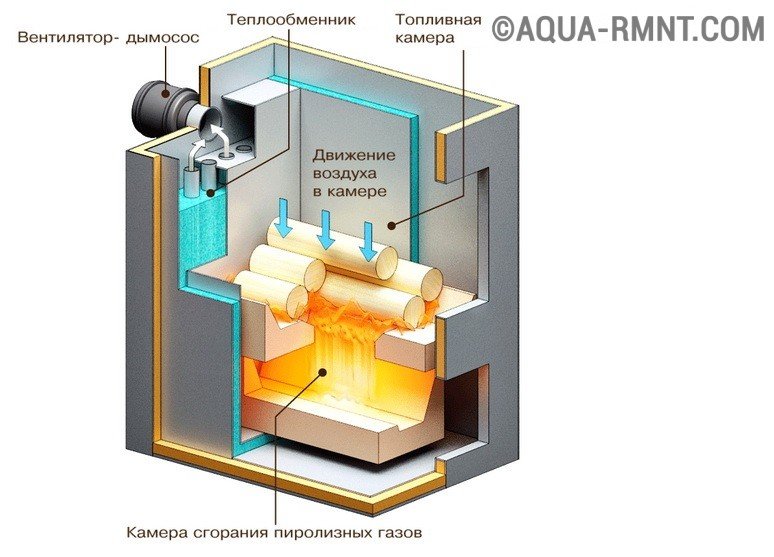
Pyrolysis boilers are distinguished by the presence of two combustion chambers. In the first, pyrolysis occurs, that is, the release of wood gas, and in the second, the actual combustion of the material
Devices of the "smoldering" type are distinguished by the presence of a water jacket built around the entire perimeter. The combustion process is like a candle - from top to bottom. The process of slow smoldering of the upper part of the fuel and the large volume of the combustion chamber, and in some cases it reaches 100 liters, allows you to stretch the combustion process for a long time.

The device of smoldering boilers is such that the fuel, set on fire from above, can burn without adding a new portion for a long time, sometimes up to several days.
There are models that can "hold out" on one coal bed for five days. To this undoubted advantage of the apparatus, one can add a slightly lower cost than that of pyrolysis boilers. However, these devices are very demanding on fuel. It must be either coal highest quality, or a tree with a moisture content of not more than 20%. It is also necessary to pay attention to the resin content in the fuel, if it is high, frequent cleaning of the system is inevitable and the automation fails faster.
Which brands should be preferred?
The most famous manufacturers of solid fuel boilers of the classical type of combustion can be considered:
- S.A.S. The company has more than 30 years of experience in the production of heating equipment. Produces more than nine models of boilers for various purposes.
- Aton. The manufacturer produces three series of devices TTK V, TTK and TRADYCJA. The first two modifications are completely non-volatile, the latter is equipped with automatic control and pressurization.
- Galmet. A large number of variations of different power, designed to work on coal, wood, briquettes, as well as combined models.
- SIME. The company offers two types of devices. The range of the Solida brand includes six boilers with power variations from 16 to 40 kW. The Solida Evolution model range is represented by five devices with a power range of 23-67 kW.
The average cost of such devices depends on the power and starts from 20 thousand rubles.
Among the most famous manufacturers of pyrolysis boilers include:
- ATMOS. Models are produced for working on coal, wood or coal, pellets, combined, with the possibility of installing a gas burner.
- VERNER. The company produces equipment of the VERNER V brand, classic pyrolysis devices designed to work on biomass. Two modifications of VERNER V45 and VERNER V25 differ in power.
The cost of devices starts from 40 thousand rubles.
The most popular manufacturers of devices of the "smoldering" type:
- Stopuva. Models with power from 10 to 40 kW are produced, working on wood or coal and wood.
- Candle. Variations of various power are produced, using firewood, wood chips, peat, briquettes as fuel.
The price of equipment starts from 40 thousand rubles.
Solid fuel boilers are reliable and practical devices. They make it possible to use almost any type of fuel, which is very convenient. The main disadvantage of classical combustion devices is the temperature fluctuations of the coolant. However, long burning modifications do not have it. This equipment can be fully automated, which makes it possible to use the device with maximum convenience.
Should I change oil or electric boilers to solid fuel boilers? Will home heating costs go down? What are they - solid fuel heating boilers?
Let's figure it out.
Selecting a heat source
Expenses
First, let's find out how cheap they are heating boilers on solid fuel compared to other sources of thermal energy. Fortunately, information on the cost of a kilowatt-hour of thermal energy received different ways, easy to find.
An important point: information is often presented somewhat biased.
For example, manufacturers of heat pumps willingly provide statistics according to which their heating method is the cheapest.
Of course, on the websites of gas equipment sellers you will find a completely different price breakdown.
Let's take data from an independent source.
They may not accurately reflect the current situation in individual regions; however, the approximate ratio will remain.
- A kilowatt-hour of heat obtained by burning main natural gas will cost about 0.52 rubles.
- for the production of a kilowatt-hour of heat, exactly one kilowatt-hour of electricity will be spent, which on average in Russia now costs about 3 rubles. When using a heat pump of any type instead of direct heating, the price of heat will decrease by about 3-3.5 times.
- During the combustion of diesel fuel, a kilowatt-hour of heat released will cost about 2.8 rubles.
- A solid fuel heating boiler when burning wood will provide us with costs at the level of 0.8 r / kWh.
- A coal-fired solid fuel heating boiler will increase costs up to 1.2 r / kWh.

The conclusions are obvious.
- Gas is the cheapest. If your home has a gas main, the choice is obvious.
- The second place is shared by solid fuel heating boilers for wood and.
- On the third - a solid fuel heating boiler that runs on coal.
The convenience of use
Cheap heating equipment evaluation begins but does not end. Another important factor is ease of use.
By what criteria can this parameter be evaluated?
- The ability to work in a completely autonomous mode for a long time.
- The ability to maintain the set temperature in the room with high accuracy. We emphasize: it is indoors. The climate in the house is non-linearly related to the temperature of the coolant: the weather outside affects it at least as much.
Any heat pump, regardless of the source of low-grade heat, is a fully automatic system and, as a rule, equipped with electronic thermostats already in the factory.
Gas boilers, as you know, are divided into non-volatile and equipped with electronic ignition. In the former, a simple mechanical thermostat is implemented; the latter are capable of using remote sensors in any part of a heated house. Neither of them require frequent maintenance.
What, in terms of convenience, can solid fuel heating boilers offer us?
- Protection of a solid fuel boiler against overheating of the coolant is, as a rule, the same simplest mechanical thermostat, which, when the critical temperature is reached, closes the blower by means of a lever and a rod.
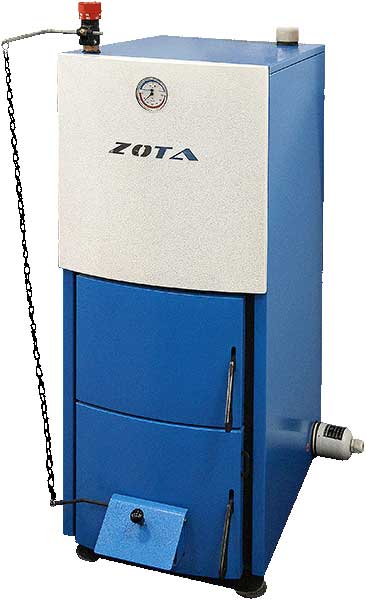
- Remote temperature sensors can only be used by gas-generating boilers, which require forced air to maintain two-stage fuel combustion. The fan speed in this case is regulated by simple electronics.
- Finally, autonomy. With her ... let's say delicately - everything is bad.
Do-it-yourself simple low-power devices burn a supply of firewood in 1-3 hours; the absolute record holder in terms of burning time is the Lithuanian solid fuel boiler Stropuva, which, thanks to an unusual fuel combustion scheme, is able to work on one tab for up to one and a half days.
We will analyze the principle of operation of upper combustion boilers of Stropuva and other manufacturers in the corresponding section of the article.
However, as usual, the devil is in the details.
- Main natural gas is not available everywhere, and the use of bottled propane practically equalizes the cost of heating with an electric boiler.
- An air source heat pump only works effectively at winter temperatures around zero degrees Celsius. With a decrease in street temperature, the consumption of electricity for the production of a kilowatt of heat increases; at -25 and below, air source heat pumps simply do not work.
- operating according to the “water-water” scheme are more versatile, but in terms of purchase and installation costs they are comparable to the costs of building a small house. For comparison: the Russian steel boilers Karakan and Dobrokhot with a capacity of 12 kW cost about 14-16 thousand rubles, and the Ukrainian 14-kilowatt Cleaver can be bought for 2,500 hryvnia (10,000 rubles at the current exchange rate).
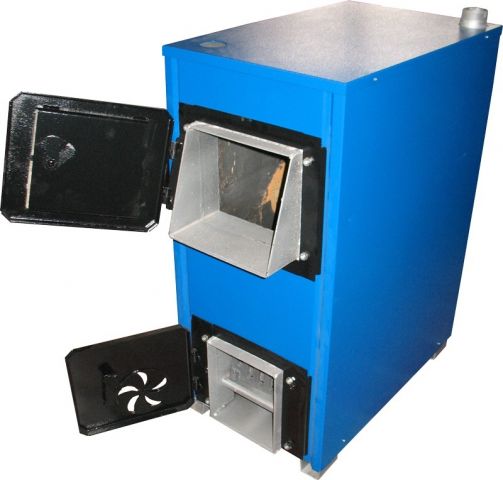
That is why in practice, where the gas pipeline is located at a considerable distance from the construction site, it is solid fuel heating installations that are leading in popularity.
Boiler types
Let's try to figure out how devices can be classified.
Material
- Steel is durable and allows you to make the walls of the boiler and heat exchanger relatively thin, and, therefore, cheap. However, the downside of low cost is limited durability. It is from steel that a huge number of home-made structures are made. Instructions and drawings, if desired, are online in minutes.
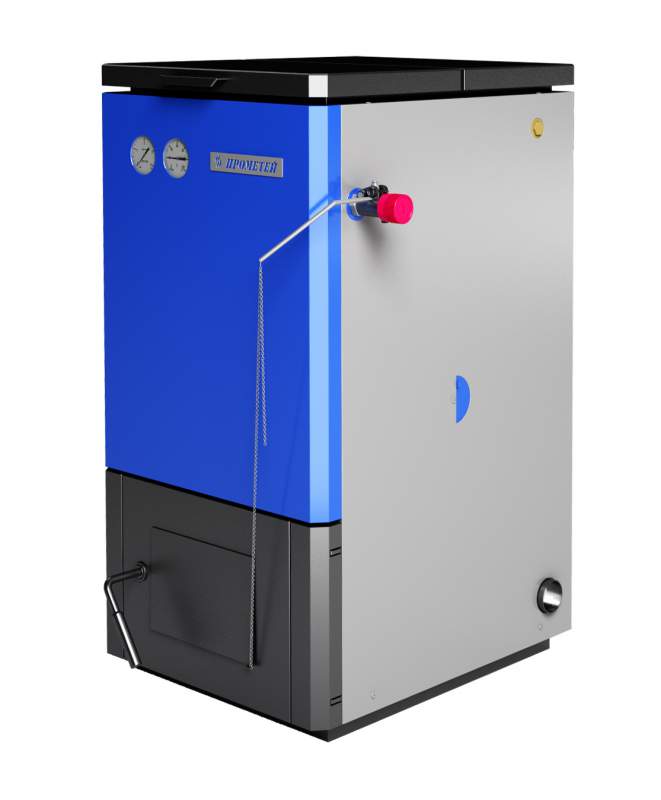
Useful: the service life of a steel firebox is significantly increased if it is lined with refractory bricks.
- Cast iron is more typical for massive devices with a power of 20 kW or more.. Low mechanical strength (primarily in relation to shock loads) makes the walls of the boiler and the firebox thick enough; as a result, the weight of the boiler can reach 250-300 kilograms.
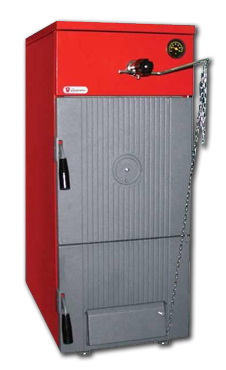
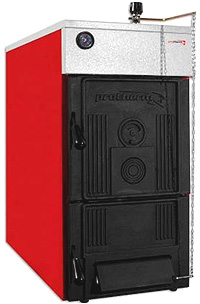
Type of fuel
- Wood boilers are able to work only and exclusively on wood with a moisture content of not more than 20%.
- Coal, respectively, are optimized for more high temperature combustion of coal.
- Pellet are designed for the use of woodworking waste pressed into granules. The advantage of devices of this type is in the automated supply of fuel from the bunker, which makes it possible to make loading quite rare; however, in practice, it is far from possible to ensure an uninterrupted supply of pellets far from everywhere, and their cost is incomparable with coal or firewood.
- Universal products can use different types fuel. A variety of combinations of thermal energy sources are possible: for example, a solar burner can be mounted in a separate firebox of a wood-burning boiler; a coal-fired boiler can be supplemented with several heating elements in a heat exchanger tank, and so on.
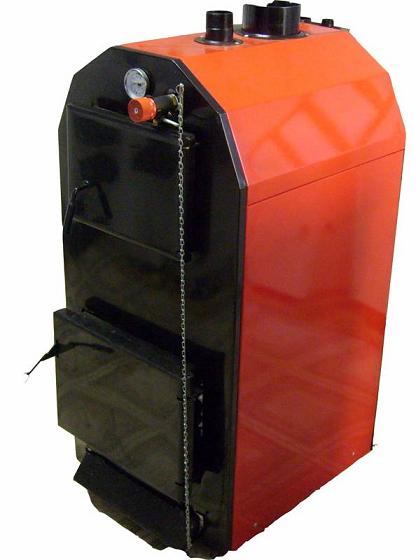
Yaik KSTGZH-16A after installing the burner in the firebox is able to switch from wood to gas or diesel fuel.
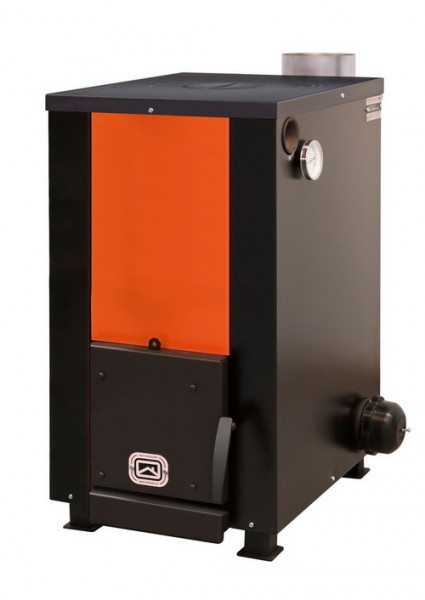
Traction type
- Natural draft comes from the difference in density between the hot combustion products and the surrounding air. The advantage of the scheme is non-volatile; the disadvantage has already been mentioned: only the most primitive control of the temperature of the coolant is possible.
An important point: the restriction of air flow through the blower means, among other things, a drop in efficiency due to incomplete combustion of the fuel.
- Forced draft allows you to flexibly adjust the thermal power of the device using programmers and remote thermostats; however, in the absence of electricity, the boiler will be shut off automatically.
Given the specifics of the Russian outback, where wire breaks and thefts are not uncommon, it is not easy to make an unambiguous choice in favor of such a solution.
Non-standard solutions
There are several designs that deserve special mention.
Pyrolysis (gas generating) boilers are distinguished by the fact that in them the combustion of fuel is divided into two phases. During the combustion of wood with limited access to oxygen, the so-called pyrolysis gas is formed, which is then burned in a separate chamber.
What is the result?
- The efficiency increases. For the best boilers of this type, it reaches 92%; in addition, the efficiency does not drop when the thermal power is limited.
- There is a minimum of solid waste.
- The regulation of the combustion process is made more flexible.
- Firewood is required every 10-12 hours.
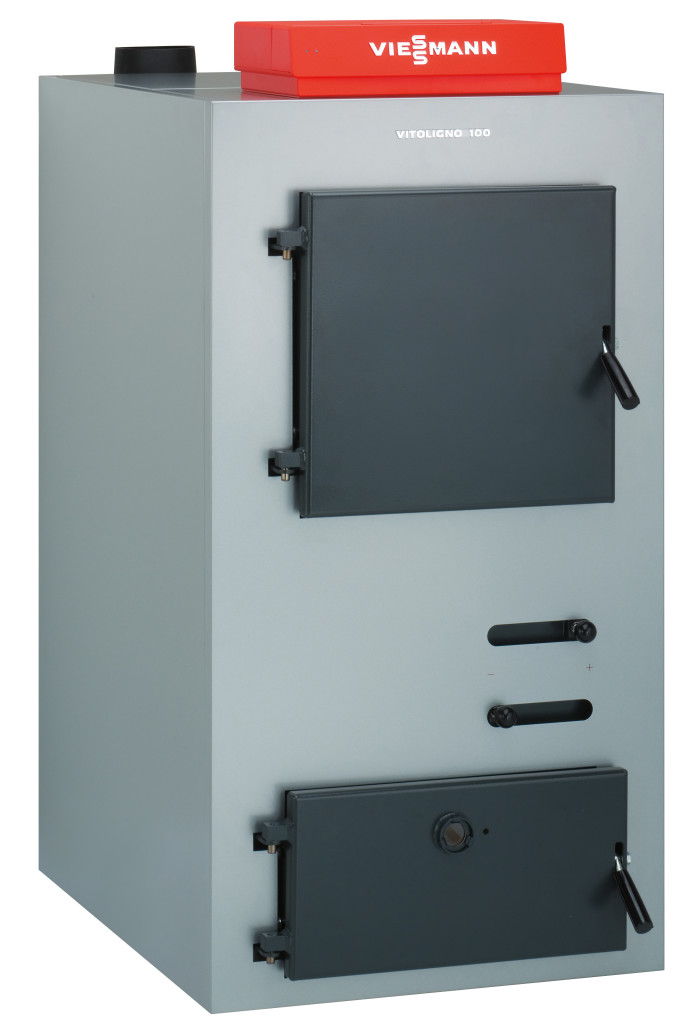
Upper combustion boilers require loading and does once every 20-30 hours. Combustion occurs only in the upper layer; firewood, coal or peat smolder with the release of pyrolysis gas, which burns out in the same furnace, but behind a massive metal separating disk. The ash is carried away by the ascending air current.
![]()
Heating and cooking boilers are equipped, in addition to the built-in heat exchanger, with a cooking surface above the furnace.
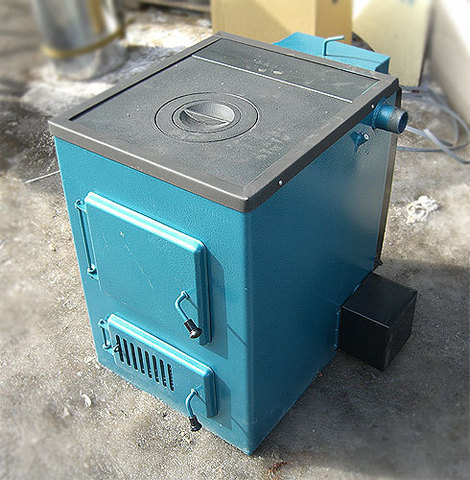
In the photo - heating and cooking Smoke AOTV-18.
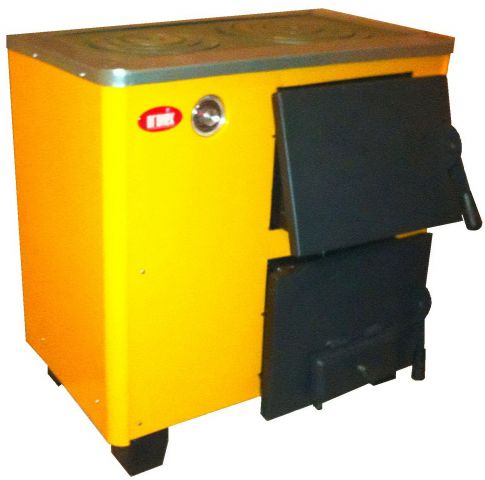
Output
Modern solid fuel heating boilers are a worthy and, most importantly, inexpensive alternative to electric and liquid fuel heating installations. As usual, in the presented video in this article you will find additional information on this topic. Warm winters!
If you do not have the opportunity to fold a classic brick oven or do not want to work as a stoker all winter, you should consider installing a long-burning solid fuel boiler. In general, solid fuel boilers operate on any type of fuel - from coal and firewood, to household waste. This is their main and undeniable advantage. And the biggest disadvantages include the fact that fuel must be regularly thrown up. Although there are models that, subject to certain requirements, require laying firewood once every 12-30 hours, and coal, in general, once every few days.
The device of a long-burning (pyrolysis) boiler is different in that it has not one combustion chamber, but two: in the first, firewood burns directly, and in the second, the resulting gases burn. Thus, a much more complete combustion of the fuel is achieved, more heat is released, and soot, when using dry fuel, is practically not formed.
In long-burning boilers, the “top burning” principle is sometimes used, that is, not the entire volume of fuel burns at the same time, but only its upper layer of approximately 15 centimeters. For this, a special air supply system has been developed directly into the combustion zone.
Today, there are so many models of boilers and companies producing them on the heating equipment market that it will not take long to get confused. Let's take a look at some of their products.
Stropuva boilers
Many people have heard about Lithuanian solid fuel boilers for long burning by Stropuva. Due to some design features, these boilers are also called gas-generating boilers. The basic design of this is 2 cylinders inserted one into the other. The space between them is filled with a coolant, and a layer of thermal insulation is applied on the outside. The smaller cylinder is the firebox itself, and the larger one is the outer casing.
The furnace consists of two chambers, which are separated from each other by an air injection zone. The lower chamber is directly a firebox, in which combustion takes place according to the “top-down” principle. The upper zone is used to preheat the air that supports the process. As the top layer burns out, the air distributor goes down. A telescopic pipe is welded to it, through which heated air enters the combustion zone.
The air is heated so as not to bring down the temperature in the furnace. For this, a special chamber is arranged, into which it enters through an air damper. This chamber is heated by gases released during combustion. Smoke, before getting into the chimney, heats the air supply chamber. This is another original solution that allows you to fully use all the heat.
The required temperature of the air supplied to the furnace is maintained by means of a draft regulator. The same regulator changes its quantity. This design allows you to improve heat removal, automatically adjust the degree of heating of the coolant and maximize the efficiency of the boiler (up to 90%).
Now on the market of heating appliances you can find 3 options for long-burning boilers from Stropuva: wood-fired, and universal (multi-fuel), running on any type of fuel.
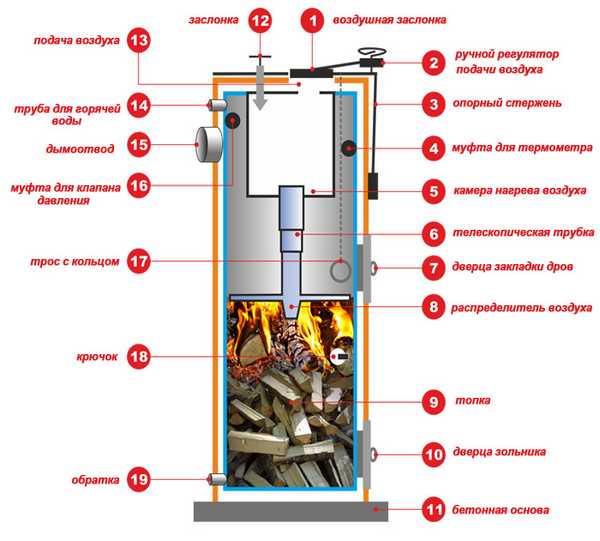
Long-burning boiler "Stropuva" internal structure
Studying reviews of Stropuva long-burning boilers, you can see that in practice everything is not as “rosy” as the manufacturers promise. One of the main disadvantages of Stropuva brand boilers, consumers call the rather complicated boiler piping, which not everyone can do on their own. The manufacturers themselves in this matter are strongly advised to contact specialists who have been trained in the campaign. The quality of the boiler depends on the correct binding. In addition, like any long-burning boiler, it is quite "capricious" to the quality of the fuel. To obtain a sufficient temperature, the moisture content of firewood should not be more than 20%. Consumers using firewood with higher humidity note the following negative consequences:
- the boiler cannot be “dispersed” above 50˚С;
- during operation, the chimney hums very strongly, “like an airplane taking off”;
- deflector burnout;
- a significant amount of soot sticking in the chimney;
- when using wood species rich in essential resins (coniferous) or tar (birch), an unpleasant odor may be observed;
- education increased amount condensate.
If providing firewood with a sufficient degree of dryness is problematic for you, then it is better to use a universal boiler that can work on anything.
At the same time, Stropuva long-burning boilers, according to consumers, have at least one indisputable advantage - burning time. Of course, it is not easy to achieve the indicators stated in the passport: on wood up to 30 hours, and on coal up to 5 days - but even without that, this boiler can be safely called the leader in the duration of burning one bookmark. If you are not ready to spend a lot of time at the boiler, this is what you need, and for its installation and proper configuration, you should definitely invite a specialist.
Lithuanian Candle
The same device (and the country of origin) have solid fuel boilers for long burning Candle. Manufacturers claim that the minimum burning time for laying firewood is 7 hours, the maximum is 34 hours. These boilers, unlike the omnivorous Stropuva, are designed exclusively for firewood.
Studying the reviews about the use of this heater, it can be noted that sometimes, when the temperature is set, smoke can seep into the room, there are complaints about the burn-out of the air supply nozzle (because of this, a spare one is provided in the package), the doors for loading firewood and cleaning ash are not very convenient ( small ones). And the price again "bites".
German quality from Buderus
The German company Buderus (Buderus) is also quite well known in the heating equipment market. The product range of this company is quite diverse. Their design is fundamentally different from the previous type of boilers. These are the so-called long-burning gas-generating boilers with a lower gas afterburner. This means that the fuel is loaded into the upper chamber (furnace), and the smoke and gases generated during the combustion process are forced down, where they burn out with the release of additional heat.
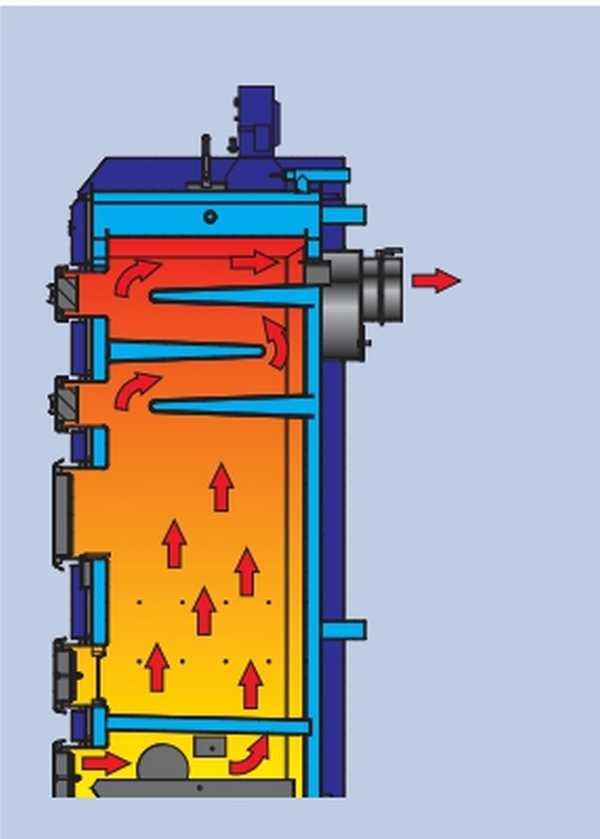
German long-burning boiler "Buderus" modification Elektromet
In the line of Buderus Elektromet boilers there is another design feature - the grate is made of pipes through which the coolant passes. This solution allows not only the full use of the generated heat, but also eliminates the problem of burnout of the grate. In these boilers, the main type of fuel is coal, it can be fired with untreated wood.
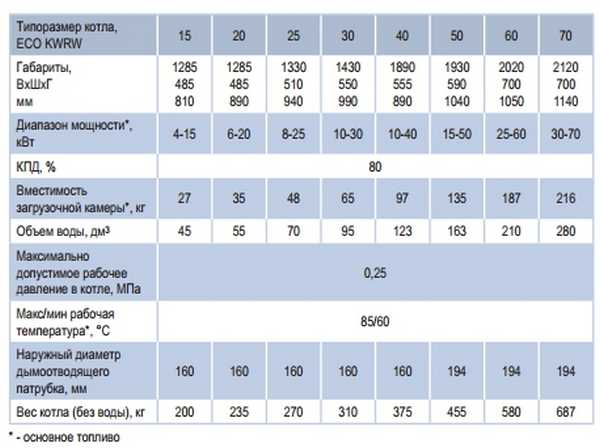
Technical characteristics of the long-burning boiler Buderus-Elektromet
The second line of German boilers - Logano - uses mainly firewood, and therefore they have a larger loading door. The upper fuel chamber is also large. This model can use coal and coke. Logano can work independently or paired with gas or.
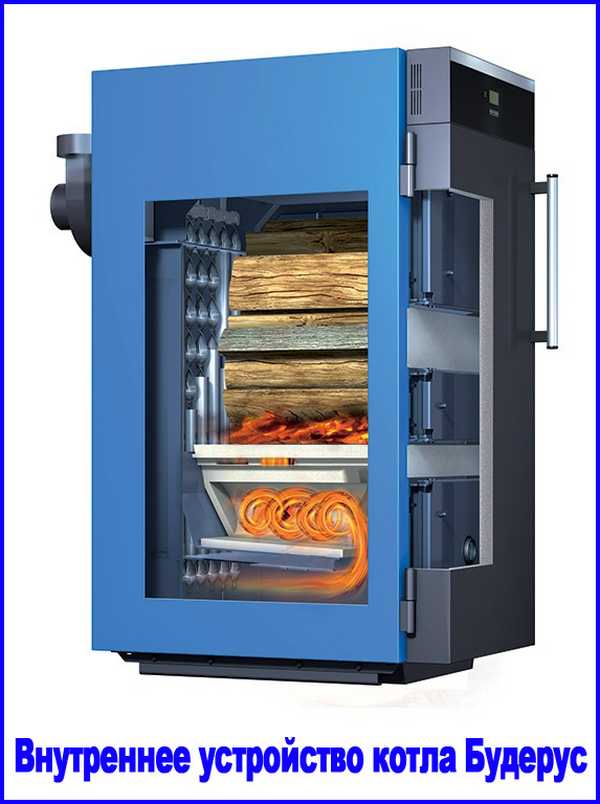
The internal structure of the boilers "Buderus"
Another model of "buderus" - Logika (Logic) - universal steel boilers that can be fired with wood, brown and coal, coal dust. Depending on the fuel, either the principle of upper combustion or lower combustion is used. Such a system allows for any fuel to achieve the best performance and minimize emissions into the atmosphere.

Buderus_Logica - universal boilers that can burn any fuel
According to consumer reviews, Buderus long-burning boilers have many advantages:
- they are very easy to operate;
- installation is not too complicated and does not require any special knowledge and skills;
- small sizes.
All maintenance comes down to loading the firebox and cleaning the ash pan once or twice a month, the rest will be done by automation. Almost all those who use this boiler for more than one year note its efficiency. Almost the only drawback that consumers blame is the rather high price. But “real German quality” cannot be cheap, right?
Omnivorous Wichlach (Vikhlach)
The long-burning boiler "Vikhlach" is another unit worthy of the closest consideration. These long-burning boilers are produced by Poland, or rather, a joint Polish-Ukrainian enterprise. Wichlach boilers are made of steel with a thickness of 5-12 mm, without the use of soldering, without external slots and slots. The dimensions of the firebox are quite impressive and, as the manufacturers promise, one bookmark should be enough for 48 hours of work.
Long-term operation is based on the principle of upper combustion of fuel, for which air is supplied directly to the combustion zone. A special point feed system has been developed, which improves combustion in problem areas: along the edges of the furnace.
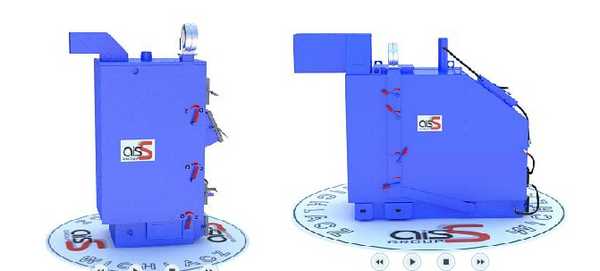
Boiler of long burning Ukrainian-Polish production "Vikhlach"
Another of the design features is water grates, i.e. these are not just pieces of reinforcement, but pipes through which the coolant flows from the system, so that ash and soot do not burn to the metal. The flowing coolant cools the steel, which makes the grate last longer. All pipes are covered with molybdenum, which almost completely eliminates the formation of rust.
Vihlach melts quickly: it reaches operating temperatures in 20 minutes. There is a possibility of smooth manual or automatic adjustment. Moreover, you can regulate the temperature of the coolant and air in the room. But to adjust the atmosphere in the room, you need to install a temperature sensor. And the main pleasant feature of this boiler is that it burns almost any fuel, of any humidity: firewood, sawdust, peat, coal - stone and brown, coal waste - fines and dust, various and solid household waste. If you need a boiler that is not capricious in relation to fuel - your choice is Wichlach.
It is quite difficult to find negative reviews about the boilers of this brand. According to customer reviews, they are economical, burn for a long time, and are undemanding in maintenance. One of its indisputable advantages is that you will never have garbage at home or at work: everything goes into the furnace. The price is also pleasing - much less than that of foreign analogues.
"Buran" burns wet reflux
Boiler of long burning "Buran" of Ukrainian production. According to its design, it is very similar to the Lithuanian Stropuva, but is much less demanding on the quality of the burned raw materials. There are also some features.
The air distributor in these boilers can rotate around its axis, which allows you to easily clean the fuel chamber from carbon deposits and ash. It is designed in such a way that it forces the air in the furnace to move clockwise. This allows you to increase the area of fuel combustion: it burns over the entire area, and not just in the center.
For efficient burning of raw fuel (firewood can be 50% moisture content), the boiler has a fan and an electric temperature controller. The doors have a special design: they can be adjusted to prevent air leakage during ignition and to prevent smoke from seeping into the room. With several movements, the density of their fit to the body changes.
In general, the developers took into account most of the shortcomings of the boilers already existing on the market, and received a very decent and high-quality version of the top combustion furnace. Buran has two lines - one for wood (using firewood, briquettes, wood waste) and universal (all the same types of fuel, plus coal).

At the price of "Buran" is quite affordable, the duration of burning is quite decent. According to factory data, a wood-fired boiler operates on one load up to 30 hours, on peat briquettes - up to 50 hours. The universal "Buran U" can not go out on coal for up to 5 days.
Unfortunately, there are very few reviews about Buran boilers, but, remarkably, not a single negative one. The unit works quietly and for a long time, economical, although it still does not always reach the declared hours of operation. It can be considered a small drawback that if you purchased a coal-fired boiler, then it is better to use larger fractions, since the fine one can sinter and burn out incompletely. Although they found a way out of this situation: the caked pieces can be reused. Due to the fact that the combustion chamber has a ribbed surface, it should be additionally cleaned a couple of times during the heating season with a metal brush.
Boiler "Prometheus"
The long-burning boiler of the Prometheus company is presented on the domestic market of heating appliances in three variations:
- "Prometheus" - a classic solid fuel boiler;
- Coal boiler with pyrolysis mode of operation of KVDG
- "Prometheus-Combi" - combined hot water;
- "Prometheus - Eco" - gas generator option;
One of the features of the classic Prometheus boiler is the grate arrangement. They consist of individual cast iron elements. This allows you to replace burned-out parts of the structure, and not the entire grille as a whole. There is also a handle for "shaking" the grate, which makes it possible to clean them during operation.

The Prometheus long-burning boiler is equipped with a suction fan. Therefore, even with an open bunker for laying fuel, smoke will not enter the room. There is also a turbulator that cleans the surface of the heat exchanger directly in the combustion process.
The equipment is undemanding in operation and is available in two modifications: it can be controlled in manual mode and automatic mode (using the control panel).
For lovers of technology comparisons, it can be noted that, according to consumer reviews, the Prometheus long-burning boiler is almost a complete analogue of the German Buderus (the only difference is in the design of the grate). However, according to consumer estimates, these are boilers of rather average, “budget” quality, although they have excellent protection automation (Italian development).
Practice has shown that "Prometheus" require more frequent cleaning compared to other brands (about once a week - one and a half), otherwise an unpleasant odor is felt. In fairness, it is worth noting that boilers from other manufacturers quite often sin with this drawback. In favor of this brand, we can say that Prometheus is much cheaper than Buderus. However, some customers complain about not very high-quality assembly and a rather inconvenient ash pan (you can get dirty when shoveling ash). In general, if you are “lucky” with the assembly, then “Prometheus” is a good “low-budget” option.
If you want to spend as little time at the boiler as possible, then you definitely need to get a long burning. The principle of its operation is that a large amount of wood pellets is loaded into a special one -. They are fed into the furnace in portions using a special auger. This is very convenient as your job is to periodically check the amount of pellets in the booker.
But, before installing such a boiler, you should ask about the cost of pellet granules and the possibility of delivery in your region. This equipment does not work on any other type of fuel. Another disadvantage is the exacting quality of raw materials and high cost. But it pays off with the economy of heating.
In general, think, consider, choose, weigh all the pros and cons, because a properly selected boiler will long years delight you with its warmth.








